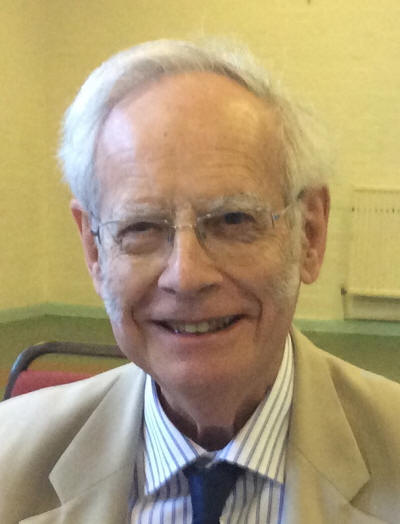Catholic Medical Quarterly Volume 66(3) Aug 2016
Reports
FEAMC Cambridge 2016
The European
Federation of Catholic Medical Associations
Dr Ian Jessiman
 The
weather in Cambridge over the Low Week weekend was beautifully sunny – if
a bit cold. There was a little rain, mainly on the Saturday evening during
our dinner, and overnight. The Backs and the College gardens were all at
their Spring best and the Fellows Garden at Magdalene, with its cascades
of daffodils, sweeping lawns and willow trees – with ducks, moorhens and
butterflies - seemed quite idyllic for our meeting, held in the new
buildings of Cripps Court.
The
weather in Cambridge over the Low Week weekend was beautifully sunny – if
a bit cold. There was a little rain, mainly on the Saturday evening during
our dinner, and overnight. The Backs and the College gardens were all at
their Spring best and the Fellows Garden at Magdalene, with its cascades
of daffodils, sweeping lawns and willow trees – with ducks, moorhens and
butterflies - seemed quite idyllic for our meeting, held in the new
buildings of Cripps Court.
A few of us arrived on the Thursday and found our own supper at a restaurant near the College. One advantage of an early arrival was time to explore a bit of Cambridge on Friday morning, or at least to discover the way about.
On Friday afternoon the ‘Scientific Committee’ met to progress the planning of the forthcoming Quadrennial Conference in Oporto from September 29th – October 2nd.
The subject, if not the title, is ‘Doctors, the Church and Europe today.’ The meeting is to be held in the diocesan seminary, the Seminário do Vilar, where accommodation is also available at very good rates.
Reduced rates for registration apply until 31st July. A special website will be ‘active’ from 18th April.
It is intended to hold workshops on the subject of migration in Europe and on the problems facing young doctors and students today. Subjects for the lecture sessions include the ‘Common Good and Healthcare systems’, ‘The Persons of the Patient and the Doctor’, the fragmentation of medical practice, the beginning and end of life, the history and future of FEAMC, and ‘Medicine and the Poor.’ Each national association is asked to prepare a poster to show their involvement in society, and there will be a session to display and explain them.
Social events would include a Concert, a dinner at one of the Port Cellars and, on the Sunday, Mass in the Cathedral followed by a tour of the city and a visit to the Shrine at Fatima.
The main FEAMC board meeting was on Saturday. Rob Hardie joined me in representing UK and giving a report. We noted that our membership and income was by no means the lowest in Europe! The presentations of each Association were interesting. Slovakia has no ‘membership’ as such, but holds regular meetings nonetheless, mainly in Bratislava. Croatia has a membership of several thousands but finds the young reluctant to join, while Slovenia has a 120 names on the roll of which some 80 pay the fee and only 15 are at all active. In Spain, only Catalonia has a proper organised association.
The meeting ended with a session on the problems of migration in Europe, conducted by Hans Stevens in preparation of a paper for the Conference in Oporto. Some of the figures were explained. Holland, the most densely populated country in Europe, had received 60,000 migrants last year and expects 100,000 this. Many of the existing inhabitants of European countries were themselves refugees in the past. Germany had accepted 1m last year. In principle we must welcome refugees ‘with intelligence.’
We cannot simply open the doors to all. Even Sweden, a well organised country, is having serious problems.
Adding to the difficulties is that a large proportion of them are Muslims, which is a way of life as well as a religion, and reconciliation is difficult. It is, at the least, essential that they learn the language and attempt to integrate: but many have never been to school and some of them do not want to do so. Ghettos must be avoided. The situation is different in each of the different European countries: In some it is the ‘rich’ who invite the immigrants – who then come and settle with the ‘poor.’ Underlying these problems is the ‘smuggling industry.’
A fundamental question is whether there are limits to charity – or, perhaps, whether the need to sustain a democratic way of life and an existing standard of living is fundamental to successful integration.
The ladies were able to explore Cambridge during the day and I have to thank Maureen for helping them find their way around. The day’s activities ended with Mass in Cripps Court said by Frs Faucher and Suaudeau (both from France).
In the evening we had a formal dinner in the old College - not, regrettably, in the Hall which was far too big for our needs and had been already booked - but in the more intimate ‘Parlour.’ Most of us had already seen the more important College buildings (Hall, Chapel, etc.) but while enjoying a pre-dinner English sparkling wine, we were also able to get a quick look at the ‘Monks room,’ a timber framed building on one of the first court stairways, dating from the 15th or early 16th century when Magdalene had started life as a monastic hostel for Benedictine students from several monasteries in East Anglia. On Sunday morning many attended the Mass at the Chaplaincy or at the main Catholic Church, before further exploring the town or making their way home.
